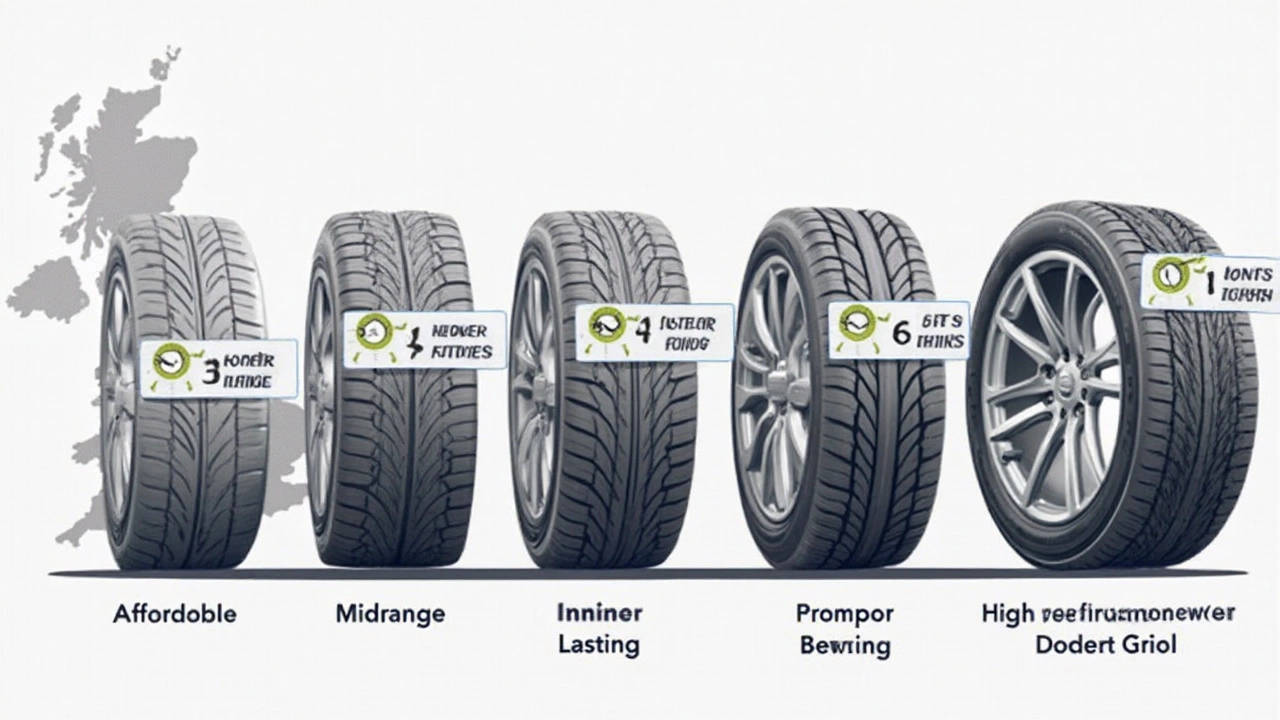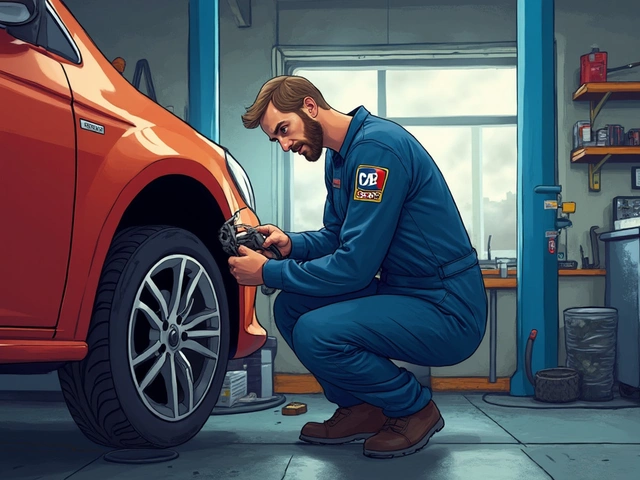Ever walked into a tire shop and felt like you were staring at a row of price tags written in a foreign language? One moment, you see a tire for seventy bucks. The next, one is pushing four hundred. So how much does a car tire really cost in 2025? Short answer: the average person in the U.S. pays about $115 to $250 per tire. But your exact number depends on a pile of factors—what you drive, how you drive, even which city you call home.
You’ve got options all over the place, from wallet-friendly brands that cover the basics to high-performance tires built for speed, quiet rides, or rough weather. And let’s not forget sneaky extras like installation fees, which can jump another $15-$45 per tire. I’ll break down what actually matters, how to avoid pointless upsells, and the biggest money pits most people don’t see coming. Buckle up, because getting the best tire deal is worth more than just a few saved dollars—it’s about driving safe and staying sane.
- What Does a Car Tire Really Cost in 2025?
- Why Tire Prices Vary so Much
- Cheap vs. Premium: What’s the Real Difference?
- Hidden Costs Most Drivers Miss
- Saving Money Without Cutting Corners
- Tips Before You Buy: What I Wish I Knew
What Does a Car Tire Really Cost in 2025?
Shopping for tires in 2025 is a little like buying sneakers—there are budget picks, flashy name brands, and everything in between. The price tag isn’t just about the rubber. It also depends on your car’s size, what type of tire you need, and where you buy it. Here’s what you’re actually looking at when you start pricing things out.
For regular sedans and compact cars, expect to pay between $100 and $180 for a mid-range daily driver tire. If you’ve got an SUV or a truck, the price creeps up—most folks see $160 to $275 each, especially if you go for something all-terrain or with run-flat features. On the flip side, electric vehicles have been shifting the market, with EV-specific tires averaging $180 to $290, thanks to their special construction for range and weight.
| Tire Type | Low Price (Each) | High Price (Each) |
|---|---|---|
| Small Car / Sedan | $70 | $180 |
| SUV / Truck | $120 | $275 |
| Performance / Sport | $170 | $400 |
| All-Season | $95 | $200 |
| Electric Vehicle (EV) | $180 | $290 |
And here’s the kicker: those prices are just the tire. Don’t forget extra costs like installation, balancing, old tire recycling fees, and taxes. Most shops toss in another $25 to $60 per tire once you factor all that in. Want to go with a shop like Costco or Walmart? Sometimes you’ll catch deals that knock installation down, or even include lifetime rotation and balancing, but you have to ask up front.
Some folks try online (think Tire Rack or Discount Tire Direct), but make sure to add shipping if they aren’t running promos. Many local shops will price match if you ask, which can save you cash if you come prepared. When it comes down to it, figuring out your total cost is less about that number on the sticker and more about the bottom-line after all the stuff gets added up.
When in doubt, use car tires as your main search term with your tire size to hunt down both big box and small local shop deals. Prices in bigger cities can be 10–15% higher, while rural areas tend to run cheaper—but don’t assume, always call at least two or three places before you buy.
Why Tire Prices Vary so Much
Walk through any tire aisle (or scroll online), and the price spread will make your head spin. It’s not just random. There are concrete reasons why the cost for car tires swings so wildly, even for similar-looking models.
First up: size. The bigger your tire, the more it’ll usually cost. A compact sedan’s 15-inch tire might be $80, while a 20-inch SUV tire can easily hit $300. Next, the type of tire matters a ton. All-season tires are the most common and tend to be cheaper. If you need specialty stuff—think run-flats, performance tires, or those with super-tough sidewalls for rugged terrain—the price jumps fast.
Brand power is real. Big global brands like Michelin, Bridgestone, or Goodyear charge more for tech, safety ratings, and the years spent on R&D. Cheaper brands, like Ironman or Westlake, keep costs low by skipping some of the high-end features or offering shorter warranties.
Let’s not ignore where you live. Tires cost more in big cities or remote areas, partly due to shipping costs and local demand. For example, Alaska and Hawaii pay the most because everything has to be shipped in. Even the time of year makes a difference. Manufacturers run big rebates and sales in late spring or early fall, which drops prices if you shop smart.
Here’s a quick look at what impacts tire prices:
- Size: More rubber, more money.
- Type: All-season, summer, winter, ultra-high performance, run-flat, off-road.
- Brand: Big names cost more but may give better tread life or warranties.
- Technology: Self-sealing, noise reduction, eco-focused compounds, etc.
- Location: Transport, taxes, and local competition shift prices.
Just to drive it home, check out this table showing how tire costs can look in real life:
| Tire Type | Average Price (2025) |
|---|---|
| Standard All-Season (15-16") | $90 - $150 |
| Performance All-Season (17-18") | $140 - $220 |
| Run-Flat (17-19") | $180 - $350 |
| Winter/Snow (15-18") | $120 - $250 |
| Truck/SUV (18-20") | $175 - $320 |
There’s a lot to think about, but knowing the reasons behind those price tags can save you serious cash—and maybe keep you from wondering if you’re getting ripped off the next time you’re tire shopping.
Cheap vs. Premium: What’s the Real Difference?
If you’re wondering whether to splurge or save on car tires, you’re not alone. It’s easy to think, “Aren’t all tires just round and rubbery?” But there’s a real gap between budget and premium options, and it’s not always obvious until you’re driving on them.
Let’s get real about what you’re paying for. Cheap tires—think entry-level brands you see on sale—usually cost $65-$100 a pop for a typical sedan size. Step up to a premium set—from big names like Michelin, Bridgestone, Continental, or Goodyear—and you’re looking at $160-$350 per tire. That’s a jump, but you’re not just buying a label.
Here’s where it actually matters:
- car tires with higher price tags tend to last much longer. A basic tire might get you 30,000 to 40,000 miles, while a good premium one can push 60,000+ miles before it’s ready for the recycling bin.
- Premiums often handle bad weather better—especially with braking, cornering, and hydroplaning. If you live where it snows or rains a bunch, that can be a life-saver.
- Cheaper tires usually make more noise, which you’ll start noticing on every road trip after month three.
- Premiums are more likely to give a smoother, quieter ride. Less vibration, less fatigue when you’re behind the wheel.
- No-name tires might not come with a mileage warranty. Big brands almost always do, sometimes covering way more than you’d expect.
If you’re curious how it stacks up with hard numbers, check out this side-by-side comparison:
| Feature | Cheap Tires | Premium Tires |
|---|---|---|
| Average Cost (per tire) | $65 - $100 | $160 - $350 |
| Tread Life Expectancy | 30,000 - 40,000 miles | 50,000 - 70,000 miles |
| Wet/Cold Weather Performance | Basic to fair | Excellent |
| Road Noise | Moderate to loud | Quiet |
| Warranty | Rare to none | Often 50,000+ mile coverage |
So, is the pricier set always worth it? If you drive a ton, care about safety in tough weather, or just hate road noise, going premium pays off over time. But if your car isn’t worth much or you barely drive, the cheap route might make more sense this time around. Just don’t expect the same ride, grip, or lifespan. Basically, you get what you pay for—no snake oil here.

Hidden Costs Most Drivers Miss
Think you’re just paying for four new tires? Not even close. There’s a whole menu of extra charges that can sneak into your bill, and they add up fast if you’re not paying attention. Most drivers walk into a shop, focus on the car tires price, and only realize after checkout there were all kinds of bonus fees tacked on.
First off, there’s mounting and balancing. Shops rarely include this in the sticker price, and you’re looking at $15–$45 per tire. That’s just for getting the tire onto the wheel and making sure it rolls smoothly. Then there’s disposal fees to toss your old tires, usually $3–$7 a tire. Sure, it sounds small until you’re changing a full set.
Don't forget valve stems or pressure sensors—those little things that keep your tires inflated or tell your dashboard when you’re running low on air. Newer cars usually need TPMS sensors checked or reset when swapping tires, with a quick “diagnostic fee” running up to $20 a pop. Valve stems themselves? Add another $3–$8 each if yours need replacing.
Warranties and road hazard coverage come next. Sometimes they're sneaky add-ons that get tossed on your bill, but the actual value can vary a ton. Some shops push lifetime balancing or flat repair, which might be nice if you drive a ton or run through potholes, but for the average commuter, they’re often not worth it.
Some places even sneak in charges for “tire disposal environmental fees” or “shop supplies.” These are vague and aren’t always explained but check your receipt and ask if they show up—most states let you say no or ask for an itemized list of extras before you pay.
- Ask for a full breakdown before agreeing to buy
- Check if mounting, balancing, and disposal are included
- Don’t get upsold on useless “lifetime” services unless you know you’ll use them
- Confirm valve stems and sensors are checked before you leave
The bottom line? The stuff you don’t see on the shelf can easily add $75–$200 to your total. Spotting these extras before the work starts saves you from some seriously annoying surprises.
Saving Money Without Cutting Corners
Tires aren’t cheap, but you don’t have to pick the sketchiest budget brand just to save cash. There are smarter ways to stretch your budget, starting with knowing the price sweet spot. Most folks end up paying way more by ignoring online deals or trusting the closest shop’s sticker price. Before you buy, check prices across a few big online retailers—places like Tire Rack and Discount Tire show real, up-to-date numbers for your car, and sometimes run promos with mail-in rebates.
Plenty of drivers miss the fact that different shops will price match, including smaller local tire stores. It never hurts to ask. Don’t skip the local warehouses either (Costco and Sam’s Club are the classics for this), especially if you already have a membership. They bundle in extras like free tire rotations or flat repairs, which add up over a few years.
Here’s a breakdown of simple moves to keep more money in your wallet:
- Shop for tires during sales—major brands run big ones around Memorial Day, Black Friday, and sometimes spring.
- Ask about installation fees before you buy. Some shops roll these in, some don’t. Hidden costs add up.
- Don’t get tricked into unnecessary add-ons like nitrogen filling or fancy “road hazard” policies unless you’ve done your homework.
- Rotate and balance your tires every 5,000 to 8,000 miles to stretch their life. It’s included free at a lot of places if you bought the tires there.
- Watch the tire’s warranty—some budget tires look cheap upfront but won’t qualify for a solid mileage warranty.
The big thing about car tires is matching what you actually need. Sure, you can grab an all-season on sale, but if you drive in snow all winter, invest in a decent all-weather model or shop for take-offs—slightly used tires pulled off new cars. Just double-check age and tread.
No shame in asking the salesperson to break down the invoice line by line. It’s your money, after all. Bottom line: a little research and a couple of questions can save you a serious chunk without risking your safety or comfort.
Tips Before You Buy: What I Wish I Knew
Before shelling out cash for car tires, there are a few things no one really tells you. I learned most of these the hard way. Here’s what you should know to keep things easy, safe, and budget-friendly.
- Check the tire size—exactly. It’s printed on the side of your tire and in your car manual. You can’t just guess. Even being off by one number can mess up your speedometer, ride, and sometimes even safety features.
- Don’t fall for the unnecessary extras. A shop might offer things like nitrogen inflation, tire wipes, or lifetime balancing. For most people, standard air works fine, and you definitely don’t need premium cleaning wipes (unless you’re showing the car at a contest).
- Compare out-the-door prices, not just the tire cost. Installation fees, recycling, valve stems, and taxes add up fast. Some places quote you just the tire and whack the extras on at the register. Always ask for the full total before you sign anything.
- New tires almost always include a treadwear warranty. Look for at least 40,000 miles coverage if you do mostly highway driving. Shorter warranties often mean softer rubber that wears out faster but can grip better in the rain.
- Age matters—even if the tire looks new. Tires start to age sitting on a warehouse shelf. Look for the four-digit DOT code on the sidewall. Something like "4323" means the tire was made in the 43rd week of 2023. Aim for tires less than 2 years old to avoid buying old stock that could crack sooner.
- Online vs. in-store? There is no right answer for everyone. Shopping online often saves money, but you’ll wait a few days and have to pay for installation somewhere else. Local shops might price-match if you ask. Bring the online quote on your phone.
Wondering about real savings? Here’s an example breakdown to spot the difference:
| Cost Item | Online Tire Shop | Local Store |
|---|---|---|
| Set of 4 Midrange Tires | $420 | $480 |
| Shipping | $30 | Included |
| Install, Balance, Disposal | $100 | $120 |
| Other Fees/Taxes | $20 | $26 |
| Total | $570 | $626 |
Notice, savings are decent, but only if you’re comfortable handling the online order, delivery, and separate installation. Sometimes the local store will match online deals if you show proof. Never hurts to ask.
And here’s one thing my wife Hannah always reminds me: read the reviews, but don’t take five-star ratings at face value. Focus on what folks say about ride comfort, noise, and durability—those matter way more than optics for daily drivers like ours.
In the end, take five minutes to double-check the basics above. That’s usually the difference between feeling good about what you paid, or wishing you’d spent a few more minutes planning ahead.


